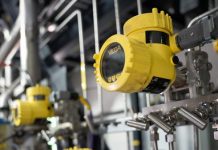Radar level measurement brings more precision to PLEXIGLAS® processes
As transparent as glass, yet lighter and tougher? That sounds like “PLEXIGLAS®”, the leading brand of acrylic glass. The chemical company Röhm GmbH produces the material in Worms, Germany, among other places, and has its various storage containers continuously monitored by VEGAPULS 6X level sensors. As these radar instruments are suitable for all media, Röhm has been able to use them at many different measuring points and thus significantly reduce its spare parts inventory.
Whether in museums, motorcars, or greenhouses: there’s hardly a place where PLEXIGLAS® is not used – although its optical properties make it really easy to overlook. Invented by Otto Röhm and trademarked since 1933, the material has distinct advantages as an alternative to glass. It is easy to shape, can be produced in almost any conceivable colour, it is also break-proof and weather-resistant. Otto Röhm saw huge potential in all of these characteristics. What else would have driven him to spend decades researching and tinkering with it? However, he could hardly have foreseen how the industrial production of the chemical compound would continue to evolve in the future.
Making improvements is the day-to-day business at Röhm
PLEXIGLAS® is available in two versions. One of them consists of semi-finished products such as sheets, tubes, rods and films, from which a wide variety of products are made. The other consists of PLEXIGLAS® moulding compounds, which are granulates used in injection moulding and extrusion processes. An important preliminary product in PLEXIGLAS® production is methyl methacrylate, or MMA for short, a viscous liquid compound.
MMA is also used in the production of paints, adhesives and building materials, among other things.
Both MMA and PLEXIGLAS® moulding compounds are produced at Röhm’s largest production site in Worms and sold in more than 100 countries. Customers can always count on punctual delivery and high quality. Because Röhm has committed itself to climate-neutral production by 2050, every initiative to increase efficiency is also considered in terms of its potential to facilitate a circular economy and recycling. Expanding capacities and achieving higher yields through intelligent and efficient process management are an inseparable part of this.
To optimise its MMA processes in accordance with sustainability goals, Röhm uses resources as efficiently as possible. The environmental guidelines laid down by management also affect operations in Stephan Bettinger’s department, which is responsible for the maintenance of all electrical systems. For his specialist team, based in building sections 311 and 111 at the extensive industrial site in Worms, “making improvements is the day-to-day business”.
More automation requires more precise measurement technology
When errors are not an option, everything depends on the 100% reliability of the manufacturing equipment and instrumentation. Precisely because automation is noticeably increasing, with more and more tasks being performed autonomously by machines, optimal design of technical processes plays a more important role than ever before.
“To reliably monitor production processes, we need innovative, high-precision sensors that transmit their measurement data centrally,” says Stephan Bettinger. For him, the primary goal is ensuring high process availability through a tightly integrated maintenance concept. But that goal is not easy to reach, as new safety and environmental regulations are being added all the time. “Everything has to run faster and more efficiently, so we have to work even more attentively and monitor processes with ever greater precision.” That’s why he critically examines each individual production step to assess its potential for improvement.
The dosage has to be right
The raw materials that go into making MMA are expensive – not least because their production and handling involves a lot of effort: acetone cyanohydrin (ACH) and sulphuric acid are basically the main ingredients. Classified as hazardous goods, the two substances place high requirements on proper handling, recycling and the reduction of waste and residual materials.
Even the smallest process deviations can have a major impact on product quality, so highly accurate VEGAPULS 6X radar sensors are used to monitor levels in the mobile storage tanks, where residues from MMA production are collected in order to feed them back into the process. During production, conditions such as pressure, temperature, and exact dosage of raw materials will influence the final consistency of the resulting MMA compound. The final properties can vary, but the ultimate goals, among others, include; better thermal conductivity, higher refractive index and higher tensile strength. Each of these special features is also the result of the raw materials recipe at the start of production.
Unused material is collected in special containers, each holding between 500 and 800 litres, and they are transported to an interim storage facility. It remains there and is used as soon as the matching formula is back on the production schedule. All of the small modular metal containers are protected against highly aggressive media and the risk of explosion, additionally they are designed to be easy to transport on pallets and easy to swap out when the product is changed.
Test instrument becomes the perfect long-term solution
“Here,” explains Stephan Bettinger, referring to the metal containers, “reliable, continuous level measurement is particularly important.” If one of the small mobile containers is full and the full signal is sent too late, some of the pumped-out residues can remain in the hoses, because there is not enough space in the container for the residues to flow out completely. “in the worst case scenario, it can mean we have mixed the residues from two different processes in the container that is subsequently returned to the production starting point.”
Over a year ago, VEGA lent a free of charge test instrument from its new VEGASPULS 6X level radar series. Now this very sensor, which was actually supposed to stay with Röhm for only three months, is still in continuous use above the metal containers. And Stephan Bettinger is absolutely delighted with it: “Previously, we used a tuning fork sensor at this measuring point to signal the full level.” But that sensor caused problems again and again due to lack of accuracy and created extra work: “To know exactly how much was left in a tank, we always had to open it and carry out a visual check.”
After the VEGAPULS 6X radar sensor was installed, this problem, and the additional work of manual inspection, has become a thing of the past. Instead of operating on the basis of a rigidly defined maximum filling limit, the radar instruments continuously measure the level and thus provide information on how full the tank is at any given moment. This allows much more proactive planning of the use of the small intermediate storage containers.
But the VEGAPULS 6X radar sensor is actually ideal for all types of storage tanks, whether large or small, and Röhm considers that to be a particular advantage. With its wide variety of process fittings and antenna designs, it can be integrated into almost any system quickly and easily. Once installed, the sensor works reliably, no matter whether the measured medium is liquid or solid, and no matter if high pressures or extreme temperatures prevail inside the tanks. Another plus point: the sensor always comes with Ex approval.
Sustainable processes, sustainable profits
For these reasons, VEGAPULS 6X is used in many different kinds of tanks. Outside the MMA plant, for example, it measures the levels in two large tanks, each with a capacity of 30 cubic metres, in which the finished product waits to be filled into barrels and dispatched – either by truck or by ship on the nearby Rhine. As soon as the radar sensor reports that one of the tanks is full, the product can be given a final quality check and loaded into the barrels provided. Because the same level sensor can be used for the small mobile residue containers and for these huge storage tanks, which also require Ex protection, the spare parts inventory at Röhm has become smaller and thus more manageable. “We now stock significantly fewer measuring instruments. This is also an important contribution to optimising our MMA process, as it allows us to work more sustainably and saves us time and costs,” says Stefan Bettinger in summary. Whether the environment, the working conditions or the profitability of the company: “They all benefit from real sustainability. It’s a win-win-win situation.”
vega.com/radar









